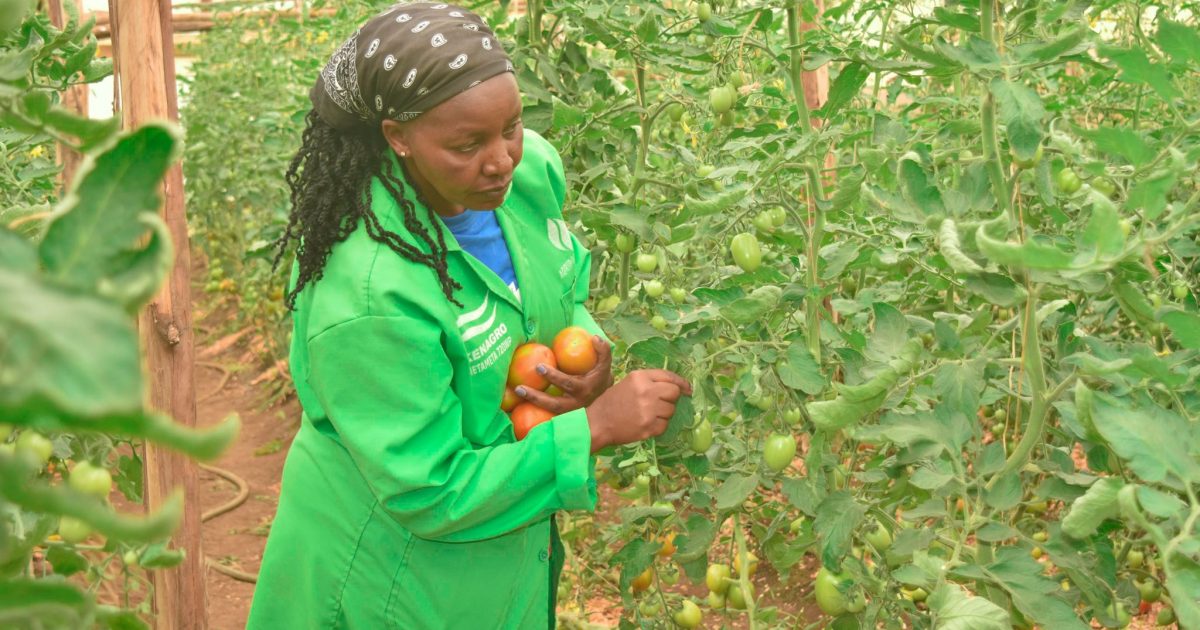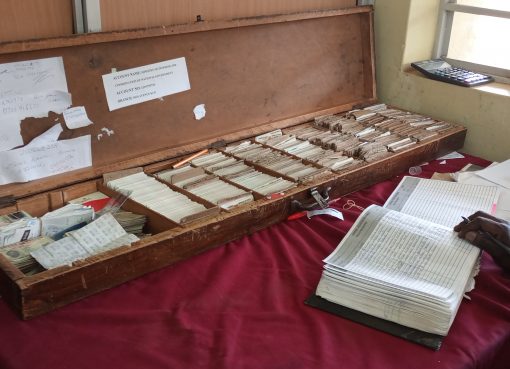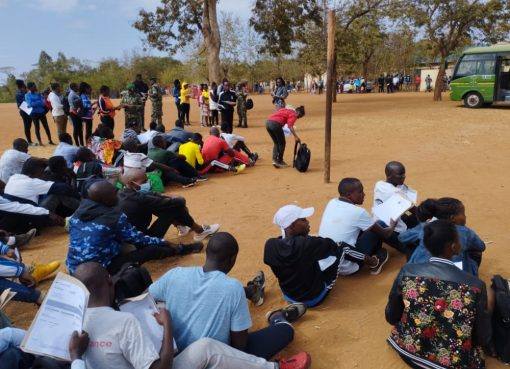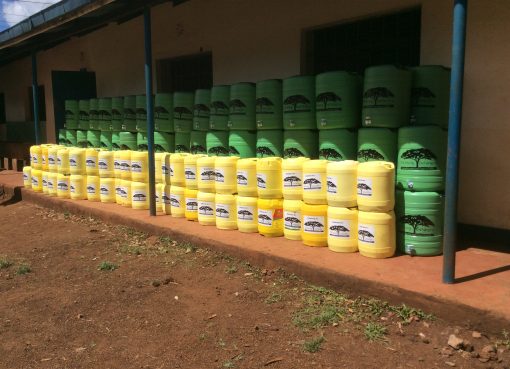Standing next to a tray with tiny tomato plants, Professor Joshua Otieno Ogweno uproots one of them then picks a razor blade, slices it into half and then uproots another plant and repeats the process.
The Associate Professor at Egerton University’s Department of Crops, Horticulture and Soils then uses a plastic rope to bind the two pieces.
“The upper one is the scion while the lower one is the root stock. The plants look the same but they are from two tomato varieties. We leave the new plant for two days to heal. If it wilts, we know it has not healed,” he explains.
Professor Ogweno who is also the Kenyan Director at Egerton University’s Confucius Institute explains that the plants are then placed in a healing chamber for three weeks before they are planted in a greenhouse.
The Don indicates that in 2019 researchers at Egerton University realized that bacterial wilt (Ralstonia Solanacearum) had become a thorn in the flesh of most tomato farmers.
He says that the agronomists learnt of a Chinese tomato variety known as wells that is tolerant to bacterial wilt.
The tomato plant grows up to 18 feet, has deep root development as well as elongates the harvest time from the usual three months to between nine to 10 months.
“The solution involves grafting a scion of the commercial Anna F1 tomato variety onto the wells variety rootstock, which is very tolerant to bacterial wilt. This method produces resilient plants that mature earlier and yield more fruit compared to un-grafted plants,” he mentions.
He adds, “We discovered it was advisable to use a resistant rootstock against soil borne diseases like bacterial wilt. Wells tomato variety is highly tolerant to bacterial wilt and its root stock has been used in Asian countries in the management of the disease,”
Professor Ogweno affirms that grafting helps control tomato pests and diseases such as nematodes, fusarium as well as bacterial wilt which is a major challenge to most farmers.
Tomato bacterial wilt, he said, is caused by a bacterium Ralstonia solanacearum, formerly known as Pseudomonas solanacearum. The pathogen has different races, each of them unique and each of them attacking different plants.
The Don explains that Tomato bacterial wilt is mostly caused by the race 1 strain, which has a wide host range and can survive in the soil for a long period of time.
He elaborates that Race 1 strains are highly variable in their genotype and aggressiveness on tomato. Some highly aggressive strains he observes, can cause severe symptoms, even on “resistant” varieties.
“Bacterial wilt often happens where plants have been cut, injured or weakened by insects or simply by cultivation. This bacterium lives in the soil and will work its way quickly through the roots and up the stem of the plants, preventing water and nutrients from reaching the leaves causing the death of the plant,” he elaborates.
Professor Ogweno discloses that Egerton University, in collaboration with Nanjing Agricultural University and the Confucius Institute, through an initiative, dubbed ‘Empowering Rural Youth through Innovative Horticultural Solutions in the Tomato Value Chain,’ has introduced the advanced grafting technology on trial basis in Nakuru, Kisumu and Nyandarua counties to boost yields and manage bacterial wilt disease in greenhouse tomato.
“Through the project funded by the International Fund for Agricultural Development (IFAD) we have trained over 4,000 farmers on green house tomato farming and grafting. We are currently working with 14 farmers in conducting trials on tomato root stocks that are resistant to bacteria wilt. We intend to move to all the 47 counties once the trials are successful,” explains Don.
He points out that the core objective of the project is to bolster food security and nutrition, reduce poverty among small holder farmers by improving quality and productivity of the crop, transferring grafting technology to locals and empowering the youth through innovative solutions in the tomato value chain.
Professor Ogweno assures that they have identified a reliable seed company that will supply the grafted tomato planting material to ensure sustainability of the project.
“Currently we have extensively trained four thousand youths from the three counties on the grafting technology. We expect that they will be trainer of trainers in their respective regions towards addressing major challenges that have compelled many farmers to abandon tomato production in greenhouses,” he explains.
The Project’s Co Principal Professor Liu Yutao states that on average, each grafted tomato plant yields between 18-22 kilograms per season, allowing farmers to harvest weekly, even during low-rainfall periods, thanks to drip irrigation systems and greenhouse technology.
Professor Yutao underscores the significance of technology transfer in the project. “The trained farmers can now do grafting on their own farms, which ensures the sustainability of the practice,” he says.
He also notes that Egerton University is actively producing grafted, disease-resistant seedlings, ensuring a steady supply for farmers in the region.
Professor Yutao is rooting for investments in the commercialization of grafted seedlings. “I urge investors to consider engaging in the commercialization of grafted seedlings. This will enable farmers to continue producing tomatoes once their current crops are harvested,” he adds.
The 14 demonstration sites of grafted tomato seedlings have been established in Molo, Njoro, Subukia, Bahati, Gilgil, Kuresoi South, and Naivasha.
Additionally, farmers practicing open-field tomato production in Rongai Sub-County have also benefited from the training.
According to the Professor the benefits of this technology extend beyond tomatoes. The grafting method can be applied to other crops, allowing farmers to diversify and enhance productivity across the region.
“The technology empowers youth, enabling them to earn a living by grafting tomatoes and other crops for local farmers and by innovatively making grafting pegs required for the process,” Professor Yutao explains.
He points out that the success of this IFAD-funded project demonstrates the potential of collaboration and technology transfer in improving agricultural practices and livelihoods for rural farmers in Kenya.
The project has also provided essential infrastructure support, repaired 14 greenhouses (each measuring 8 by 15 meters) and supplied both grafted and un-grafted seedlings to farmers.
This controlled environment helps minimize common challenges such as bacterial wilt and other pests, ensuring healthier crops and higher yields for the farmers involved.
Mary Wambui, a farmer from Turi in Molo Sub-County, shares her experience: “Bacterial wilt used to ruin our crops, but since we started using this grafting technology, our harvests have improved significantly. I now sell each tomato for Sh 10, and my customers love the large size of the tomatoes,”.
Her husband, John Mwangi, noted that neighbouring farmers, impressed by their success, are eager to adopt the same methods.
Another beneficiary, Mary Muthoni from Tayari Farm in Molo Sub-County, also credits the technology with increasing her income.
“I can now graft my own plants after buying certified seedlings from local agrovets. My weekly earnings have risen to Sh 7,000, up from Sh 3,000 when I first started,” Muthoni explains.
By Anne Mwale





